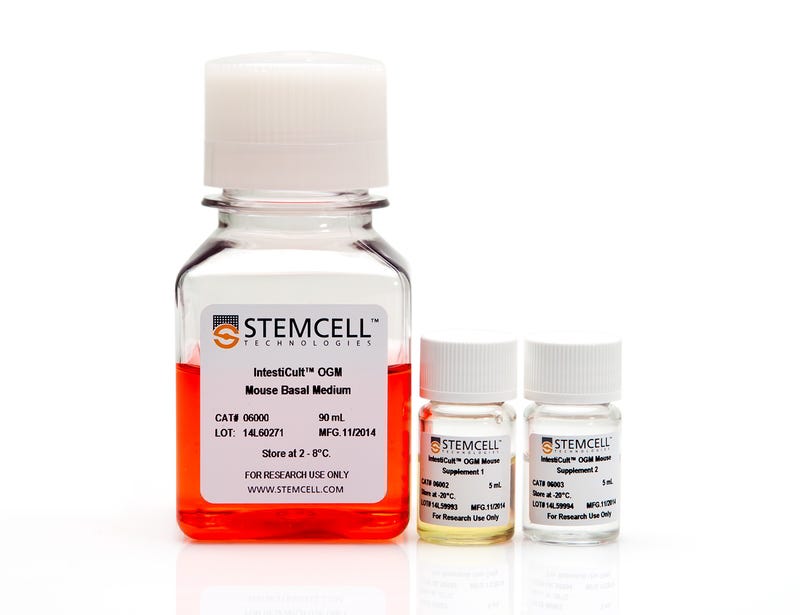IntestiCult™ Intestinal Organoid Culture Media
IntestiCult™ Intestinal Organoid Culture Media
IntestiCult™ organoid culture media are complete growth media that support establishment, expansion, long-term maintenance, and further differentiation of intestinal organoid cultures from human or mouse intestinal crypts. Developed in collaboration with Dr. Hans Clevers and Foundation Hubrecht Organoid Technology (The HUB) this complete and defined medium generates organoids from intestinal crypts in less than a week. These ‘mini-guts’ retain the crypt- and villus-like domains, a central lumen and all major cell types found in the adult intestinal epithelium. The organoids are functional and ready for use in a number of research applications including disease modeling, drug screening and tissue regeneration.
Addressing the Challenges in Intestinal Research
Studying the intestinal epithelium can pose multiple challenges. Traditional in vitro monolayer cultures are convenient but lack key structural features and the cellular diversity of an adult intestine. In vivo animal models allow experimentation on an intact intestine but are often more difficult and expensive to run, and provide limited relevance to human physiology. Intestinal organoids address many of these issues by providing a convenient in vitro system that has high physiological relevance.
What are Intestinal Organoids?
Intestinal organoids are three-dimensional multicellular structures that retain key features of the adult intestinal epithelium, such as the crypt- and villus-like domains, a central lumen and the major cell types: intestinal stem cells, Paneth cells, goblet cells, enteroendocrine cells and enterocytes. Organoid culture is a convenient and physiologically relevant tool that can be used in a variety of research applications.
Why Use IntestiCult™?
- A complete medium that does not require additional growth factors.
- Organoids retain key features and all major cell types found in the adult intestinal epithelium.
- Efficient and reproducible generation of organoids in less than one week.
- Simple format and easy-to-follow optimized protocol.
Find the Right Media for Your Intestinal Research
Use the Interactive Product Finder to determine which IntestiCult™ media is best suited for your intestinal epithelial cell research.
Intestinal Organoid Culture Media
Brand History
Dr. Hans Clevers and his research team have made significant contributions to the field of stem cells and organoid culture. In 2007, Dr. Nick Barker et al. identified the presence of LGR5+ stem cells in the intestinal crypt. In 2009, Dr. Toshiro Sato et al. published a protocol for establishing organoid structures from intestinal crypts or single intestinal stem cells. The protocol described the culture conditions that would support long-term expansion of these organoids without requiring a mesenchymal niche. In 2014, Dr. Clevers and The HUB foundation for Organoid Technology signed an agreement with STEMCELL Technologies to manufacture and distribute cell culture media for organoids. Since then, the release of IntestiCult™ Organoid Growth Medium (Mouse) in 2015, and IntestiCult™ Organoid Growth Medium (Human) in 2017 has provided researchers with a convenient, complete and affordable medium for establishing organoid cultures.
Watch a webinar on organoids as a model for human disease by Dr. Clevers >
We are pleased that STEMCELL will be our partner in making specialty media for growth of organoids available to the scientific community. The broad availability of off-the-shelf cell culture media from a world leader in the development of specialized cell culture media and cell separation products represents an essential step in the further implementation of this exciting technology.
Dr. Hans Clevers, Founding Director of The HUB
Scientific Resources
Explore our resources to learn more about organoids, and learn how to generate, culture, and differentiate intestinal organoids.
- Protocols and technical tips
- Webinars and videos
- Organoid Research Techniques Ebook
- Online learning classroom
Key Applications of Intestinal Organoids
Epithelial Cell Biology
Intestinal Stem Cell Niche
Gene Expression and Function
Infection and Immunity
Wilson SS et al. (2014) A small intestinal organoid model of non-invasive enteric pathogen-epithelial cell interactions. Mucosal Immunol 8(2): 352-61.
Zhang YG et al. (2014) Salmonella-infected crypt-derived intestinal organoid culture system for host-bacterial interactions. Physiol Rep 2(9): e12147.
Transplantation and Engraftment
Cystic Fibrosis
Schwank G et al. (2013) Functional repair of CFTR by CRISPR/Cas9 in intestinal stem cell organoids of cystic fibrosis patients. Cell Stem Cell 13(6): 653-8.




